The fix for the crossover is almost certainly just to use the correct component values in the mid/tweeter section. This may require the replacement of only a single component depending on what the fault actually is and since it is the mid/tweeter section the components are not going to be expensive.
Andy,
I haven't got them back yet and do understand your point of view.
Before making those changes I would need to get a correct layout for this crossover from them (I am not convinced my crossover is the same as the multiple circuit diagrams shown previously). Then measure it all and go from there.
I still have concerns that even if I fix the crossover point of mid-tweeter, it won't perform as well as is possible, as I don't think there is any inherent EQ or 'tailoring' in the crossover to account for the driver freq responses or breakups.
I've already said what is wrong with the original KatieandDad and bushmeister crossover. And how to fix it.
http://www.diyaudio.com/forums/multi-way/210627-wilmslow-audio-prestige-platinum-59.html#post4307163
You only have to look at bushmeisters +++ measurements to see a phase problem and a slope problem in the mid to tweeter transition. Really quite simple, IMO. But waffle on by all means. Me, I'd fix it.
Wow System7!, 'waffle on by all means' ?!?
Sorry I missed your post earlier buried in the myriad of posts on this thread! I suppose you could never be accused of 'waffling on' about the same old bees in your bonnet!?!?
Still, thank you for taking the time to look at the crossover. Was your specific advice based on my photos of the physical crossover I have or on one of the multiple schematics shown - there have been a few, and I am not certain my crossover is the same - are you?
The last thing I need to do is start replacing components if assumptions have been made based on the wrong circuit layout/values. Perhaps I should post them over to you to fix, so I don't 'waffle on' any more?
Having spent a fair bit of time measuring the crossovers in lots of configurations, establishing a problem, posting about it here, writing e-mails back and forth to WA, posting about that here, driving to WA to be told 'all is fine' etc I have spent many hours trying to get these crossovers sorted, and I am no further forward - lots of 'waffle' and time wasted.
Don't forget these speakers are up and working well - see my most recent measurements - with an active crossover. If WA had 'fixed' these crossovers I would probably have used them as a yardstick against an active crossover implementation, rather than use the passive crossover.
There is going to be a lot more 'waffling on' if I start the laborious process of measuring every component in the crossover and tweaking it to get a half decent result in the boxes, so System7, if I go down this route - are you going to stand by me and my waffling?!
Last edited:
I understand what Steve is saying because all you have to do is:
1. Post a copy of your crossover circuit to make sure we are talking about the correct crossover as measured by Steve. If it is, try his suggested mods.
2. In any event reply to Wilmslow stating that a crossover designed to cross at 380/3,800 is unfit for purpose for use with the supplied Volt mid the specs of which are 'Frequency response 500Hz - 4000Hz'.
As noted previously, 380/3,800hz cross points is the spec recommended for the ATC mid
Not hard really........
1. Post a copy of your crossover circuit to make sure we are talking about the correct crossover as measured by Steve. If it is, try his suggested mods.
2. In any event reply to Wilmslow stating that a crossover designed to cross at 380/3,800 is unfit for purpose for use with the supplied Volt mid the specs of which are 'Frequency response 500Hz - 4000Hz'.
As noted previously, 380/3,800hz cross points is the spec recommended for the ATC mid
Not hard really........
I really feel like I am talking to myself here.......
These speakers have £2500 worth of drivers in them. The WA crossover everyone seems desperate to make work is likely a fudged crossover for a different mid driver (16ohm ATC), which has therefore not been designed to work with the frequency response of the volt mid (or in fact the ring radiator tweeter).
If you read back through the responses from WA, I do not believe it has been designed with careful shelving, notch filters etc to optimize it for the ATC driver either.
Making the changes suggested by System7 may well cross the tweeter over to the mid correctly, but will it address the measured freq responses (I made!) in the cabinets optimally, with appropriate power response, phase response, optimum suppression of driver break up etc. etc.?
Or would it be a starting point that would then require a lot of reworking, tweeking, to make it worthy of the £2500 worth of drivers?
Will it allow correction for room modes, or creation of various 'house curves', or be flexible when I build new cabinets?
I was under the impression that creating a really excellent three-way passive crossover was a fairly difficult task and required a lot of time, listening sessions, measurements and skill. Particularly if the drivers don't have lovely flat frequency responses.
Say I get the crossover point moved by making the changes System7 suggested that are 'not hard really'. Is it going to be significantly better than the measured response of my active crossover I posted a few days ago?
With all due respect to the passive die-hards here, I cannot see System7's changes making me happy with the crossover in one simple, easy fix as you are all implying.
But more importantly, and I am going to say this one last time, I always planned to go active with these speakers (as I have said since the beginning - see my first two posts after picking the speakers up - #524 and #527), all my other speakers are active (as I have said since the beginning), and I believe that there are inherent advantages to going active (particularly digital) with speaker drivers like these (as I have said before many times), and therefore, that is my plan.
I am really sorry if this is annoying to those that want me to spend time fixing the crossovers and reporting back my measurements etc, but some people like horns, some people like open baffles, some people swear by passive crossovers, and some prefer active.
I like active boxes, preferably three-way. I am not being lazy by making a decision not to spend time sorting the passive crossovers out. I don't wish to have passive speakers.
In all honesty I didn't want to spend the time I have already chasing up the whole passive crossover debacle in the first place. But I felt I owed it to WA (as they have always been excellent in the past) to try to put things right and explain the completely wrong measurements for their own reputation. When I first got the speakers I was going to simply bin the crossovers and not bother with them - I somewhat wish I had now!
Sorry if this doesn't fit in with other peoples plans.
Remember, I didn't buy these as a kit to build passive speakers, I bought these as a incomplete project off someone else to use in my own way. Ultimately I am likely to build new cabinets for them anyway, as I do not believe that the cabinets they are housed in now are the best possible for such high-end drivers (I will probably explore a CLD approach).
I really hope this draws a line under the whole thing. Now, can we all please move on!


These speakers have £2500 worth of drivers in them. The WA crossover everyone seems desperate to make work is likely a fudged crossover for a different mid driver (16ohm ATC), which has therefore not been designed to work with the frequency response of the volt mid (or in fact the ring radiator tweeter).
If you read back through the responses from WA, I do not believe it has been designed with careful shelving, notch filters etc to optimize it for the ATC driver either.
Making the changes suggested by System7 may well cross the tweeter over to the mid correctly, but will it address the measured freq responses (I made!) in the cabinets optimally, with appropriate power response, phase response, optimum suppression of driver break up etc. etc.?
Or would it be a starting point that would then require a lot of reworking, tweeking, to make it worthy of the £2500 worth of drivers?
Will it allow correction for room modes, or creation of various 'house curves', or be flexible when I build new cabinets?
I was under the impression that creating a really excellent three-way passive crossover was a fairly difficult task and required a lot of time, listening sessions, measurements and skill. Particularly if the drivers don't have lovely flat frequency responses.
Say I get the crossover point moved by making the changes System7 suggested that are 'not hard really'. Is it going to be significantly better than the measured response of my active crossover I posted a few days ago?
With all due respect to the passive die-hards here, I cannot see System7's changes making me happy with the crossover in one simple, easy fix as you are all implying.
But more importantly, and I am going to say this one last time, I always planned to go active with these speakers (as I have said since the beginning - see my first two posts after picking the speakers up - #524 and #527), all my other speakers are active (as I have said since the beginning), and I believe that there are inherent advantages to going active (particularly digital) with speaker drivers like these (as I have said before many times), and therefore, that is my plan.
I am really sorry if this is annoying to those that want me to spend time fixing the crossovers and reporting back my measurements etc, but some people like horns, some people like open baffles, some people swear by passive crossovers, and some prefer active.
I like active boxes, preferably three-way. I am not being lazy by making a decision not to spend time sorting the passive crossovers out. I don't wish to have passive speakers.
In all honesty I didn't want to spend the time I have already chasing up the whole passive crossover debacle in the first place. But I felt I owed it to WA (as they have always been excellent in the past) to try to put things right and explain the completely wrong measurements for their own reputation. When I first got the speakers I was going to simply bin the crossovers and not bother with them - I somewhat wish I had now!
Sorry if this doesn't fit in with other peoples plans.
Remember, I didn't buy these as a kit to build passive speakers, I bought these as a incomplete project off someone else to use in my own way. Ultimately I am likely to build new cabinets for them anyway, as I do not believe that the cabinets they are housed in now are the best possible for such high-end drivers (I will probably explore a CLD approach).
I really hope this draws a line under the whole thing. Now, can we all please move on!
Last edited:
A final post regarding these ill fated crossovers...
WA have very kindly agreed to exchange them with me as they are surplus to requirements. Therefore, they are no longer an option anyway.
There's nothing kind about exchanging goods that are clearly unfit for purpose.....
Good heavens the plot thickens! Exchange them for what value? Who made the suggestion? I still find it hard to take that unexpected reply at face value given Wilmslow are in the DIY speaker business.A final post regarding these ill fated crossovers...
WA have very kindly agreed to exchange them with me as they are surplus to requirements. Therefore, they are no longer an option anyway.
At the risk of waffling, I have to say I think Bushmeister has made exactly the right choice. Going active is always more flexible overall than a passive crossover and should yield better results. You should be able to take it significantly beyond the performance level of the passive design.
Good heavens the plot thickens! Exchange them for what value? Who made the suggestion? I still find it hard to take that unexpected reply at face value given Wilmslow are in the DIY speaker business.
Yeah odd decision by them on this speaker, what I don't get is it's their best selling speaker round the world with great reviews for the most part.
At the risk of waffling, I have to say I think Bushmeister has made exactly the right choice. Going active is always more flexible overall than a passive crossover and should yield better results. You should be able to take it significantly beyond the performance level of the passive design.
I completely agree, much more flexible, especially when using a difficult driver like the ATC.
Never is black and white is it, so many choices to be made. One of the things that always amazes me is choices that often seem wrong sometimes sound so right despite themselves.
I think active has really come of age recently, with DSP getting cheaper and more advanced and small a cheap amps becoming commonplace.
I think active has really come of age recently, with DSP getting cheaper and more advanced and small a cheap amps becoming commonplace.
Not sure active has come of age per se as there is still as much resistance in the mainstream hifi market as there was 25 years ago when I first heard a pair of active speakers. but for the DIY crowd there are certainly a lot more options and more flexibility.
The speakers 25 years ago were the meridian D600 (too bright didn't like) and the ATC SCM50A (amazing and still wish i could afford them).
The speakers 25 years ago were the meridian D600 (too bright didn't like) and the ATC SCM50A (amazing and still wish i could afford them).
I've been quietly working at this Wilmslow Audio Prestige speaker. First, let's decide on the RIGHT IDEA on implementation of your standard 3 way design. It's pure Steen Duelund. You just go for a target response as in the first image below.
So where does the Wilmslow speaker go wrong?
** Firstly, that a soft dome mid has a steep rise into its presence band. Nearly LR4. The bass filter however is second order, so is LR2. This is not what Celestion did in the Ditton 66. They used steeper 4th order bass and it worked better. So phase is a mess between the bass and the soft dome mid. Hence the unusual ++ polarity. About 700kHz crossover.
** Secondly, with a second order LR2 rolloff to the soft dome mid, you must use second order slope and 3.5kHz filter on the tweeter. This is a negative polarity solution with good time alignment, which of course is a bit driver dependent too, but the overall polarity is ++-.
** Thirdly, Wilmslow have a huge variation of drivers on this model. The bass and tweeter filters are quite a moveable feast. But actually, the mid filter resolves itself to be quite fixed.
So the second image is the troublesome and wrong KatieandDad filter. The third image is the much better juancho filter. The fourth image is my generic solution followed by its frequency response and phase on ++-. I'd be comfortable tuning the tweeter and mid level by ear just by changing resistors, but I'd need to model the precise bass carefully because slopes are very driver dependent.
Overall, I think Wilmslow finally got it about right with the juancho filter in image 3. I came up with similar if we get the polarity to ++-. Complicated post for a complicated speaker. Hope it helps.
So where does the Wilmslow speaker go wrong?
** Firstly, that a soft dome mid has a steep rise into its presence band. Nearly LR4. The bass filter however is second order, so is LR2. This is not what Celestion did in the Ditton 66. They used steeper 4th order bass and it worked better. So phase is a mess between the bass and the soft dome mid. Hence the unusual ++ polarity. About 700kHz crossover.
** Secondly, with a second order LR2 rolloff to the soft dome mid, you must use second order slope and 3.5kHz filter on the tweeter. This is a negative polarity solution with good time alignment, which of course is a bit driver dependent too, but the overall polarity is ++-.
** Thirdly, Wilmslow have a huge variation of drivers on this model. The bass and tweeter filters are quite a moveable feast. But actually, the mid filter resolves itself to be quite fixed.
So the second image is the troublesome and wrong KatieandDad filter. The third image is the much better juancho filter. The fourth image is my generic solution followed by its frequency response and phase on ++-. I'd be comfortable tuning the tweeter and mid level by ear just by changing resistors, but I'd need to model the precise bass carefully because slopes are very driver dependent.
Overall, I think Wilmslow finally got it about right with the juancho filter in image 3. I came up with similar if we get the polarity to ++-. Complicated post for a complicated speaker. Hope it helps.
Attachments
-
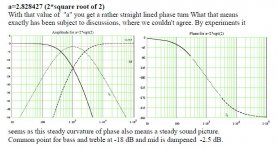 Duelund a=2.83.JPG72.1 KB · Views: 433
Duelund a=2.83.JPG72.1 KB · Views: 433 -
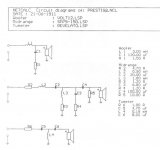 Wilmslow Prestige Circuit.JPG38.6 KB · Views: 1,079
Wilmslow Prestige Circuit.JPG38.6 KB · Views: 1,079 -
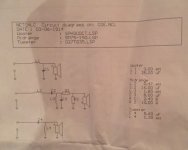 Wilmslow Audio Prestige Monacor Bass.JPG19.2 KB · Views: 788
Wilmslow Audio Prestige Monacor Bass.JPG19.2 KB · Views: 788 -
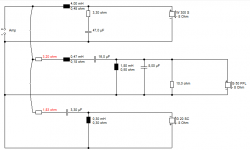 S7 Generic Soft Dome Mid Circuit.PNG10.3 KB · Views: 2,978
S7 Generic Soft Dome Mid Circuit.PNG10.3 KB · Views: 2,978 -
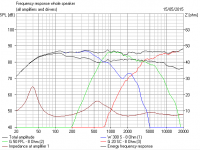 S7 Prestige Generic Soft Dome Mid FR ++-.PNG25.5 KB · Views: 422
S7 Prestige Generic Soft Dome Mid FR ++-.PNG25.5 KB · Views: 422 -
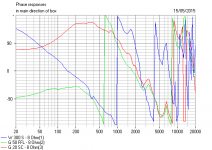 S7 Prestige Generic Soft Dome Mid Phase ++-.PNG28 KB · Views: 181
S7 Prestige Generic Soft Dome Mid Phase ++-.PNG28 KB · Views: 181 -
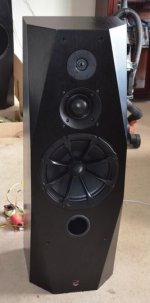 KatieandDad WA Speaker.JPG27 KB · Views: 2,141
KatieandDad WA Speaker.JPG27 KB · Views: 2,141
Last edited:
You do realize the simulation is based on Visaton drivers from
their database in Boxsim? Yes, I understand it's harder to trace the
plots of the actual units, a couple of hours of work easily.
Even then it would have been flawed to a certain degree.
You do realise it's possible to import other drivers in Boxsim? However, I bite my hand and let Steve answer...
Boxsim can do a lot, no question about it, only Steve has a certain
way of doing things and he sticks to it which does not negate some
relevance in helping to sort out issues.
In case it's not clear enough, when doing simulations, especially
when we have generic manufacturer plots, it would have made more
sense to use those. There is one huge issue with it, it costs time
and labor, so Sreten is totally right when he says he is not prepared
to do the job for all those in "need" of it. I am slowly getting there too.
In case I hurt someone's feelings, I apologize.
way of doing things and he sticks to it which does not negate some
relevance in helping to sort out issues.
In case it's not clear enough, when doing simulations, especially
when we have generic manufacturer plots, it would have made more
sense to use those. There is one huge issue with it, it costs time
and labor, so Sreten is totally right when he says he is not prepared
to do the job for all those in "need" of it. I am slowly getting there too.
In case I hurt someone's feelings, I apologize.
Last edited:
Not sure active has come of age per se as there is still as much resistance in the mainstream hifi market as there was 25 years ago when I first heard a pair of active speakers. but for the DIY crowd there are certainly a lot more options and more flexibility.
The speakers 25 years ago were the meridian D600 (too bright didn't like) and the ATC SCM50A (amazing and still wish i could afford them).
I think Orangeart meant that active implementation is now a lot easier than it used to be. There are more filter kits available and DSP kits like the MiniDSP and Hypex make experimentation simpler. Mainstream hifi has largely ignored it because it wants you to keep swapping amplifiers. As more 'lifestyle' products appear and the demand for quality increases, we're likely to see more active speakers by stealth, rather in the way B&O have been doing for 25+ years.
Just because a speaker is active doesn't mean it's automatically good, of course.
- Status
- This old topic is closed. If you want to reopen this topic, contact a moderator using the "Report Post" button.
- Home
- Loudspeakers
- Multi-Way
- Wilmslow Audio - Prestige platinum